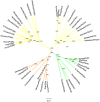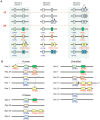Concomitant duplications of opioid peptide and receptor genes before the origin of jawed vertebrates
- PMID: 20463905
- PMCID: PMC2865548
- DOI: 10.1371/journal.pone.0010512
Concomitant duplications of opioid peptide and receptor genes before the origin of jawed vertebrates
Abstract
Background: The opioid system is involved in reward and pain mechanisms and consists in mammals of four receptors and several peptides. The peptides are derived from four prepropeptide genes, PENK, PDYN, PNOC and POMC, encoding enkephalins, dynorphins, orphanin/nociceptin and beta-endorphin, respectively. Previously we have described how two rounds of genome doubling (2R) before the origin of jawed vertebrates formed the receptor family.
Methodology/principal findings: Opioid peptide gene family members were investigated using a combination of sequence-based phylogeny and chromosomal locations of the peptide genes in various vertebrates. Several adjacent gene families were investigated similarly. The results show that the ancestral peptide gene gave rise to two additional copies in the genome doublings. The fourth member was generated by a local gene duplication, as the genes encoding POMC and PNOC are located on the same chromosome in the chicken genome and all three teleost genomes that we have studied. A translocation has disrupted this synteny in mammals. The PDYN gene seems to have been lost in chicken, but not in zebra finch. Duplicates of some peptide genes have arisen in the teleost fishes. Within the prepropeptide precursors, peptides have been lost or gained in different lineages.
Conclusions/significance: The ancestral peptide and receptor genes were located on the same chromosome and were thus duplicated concomitantly. However, subsequently genetic linkage has been lost. In conclusion, the system of opioid peptides and receptors was largely formed by the genome doublings that took place early in vertebrate evolution.
Conflict of interest statement
Figures







Similar articles
-
Ancestral vertebrate complexity of the opioid system.Vitam Horm. 2015;97:95-122. doi: 10.1016/bs.vh.2014.11.001. Epub 2015 Jan 23. Vitam Horm. 2015. PMID: 25677769 Review.
-
Opioid Peptides and Their Receptors in Chickens: Structure, Functionality, and Tissue Distribution.Peptides. 2020 Jun;128:170307. doi: 10.1016/j.peptides.2020.170307. Epub 2020 Mar 23. Peptides. 2020. PMID: 32217145
-
The vertebrate ancestral repertoire of visual opsins, transducin alpha subunits and oxytocin/vasopressin receptors was established by duplication of their shared genomic region in the two rounds of early vertebrate genome duplications.BMC Evol Biol. 2013 Nov 2;13:238. doi: 10.1186/1471-2148-13-238. BMC Evol Biol. 2013. PMID: 24180662 Free PMC article.
-
Evolution of vertebrate opioid receptors.Proc Natl Acad Sci U S A. 2008 Oct 7;105(40):15487-92. doi: 10.1073/pnas.0805590105. Epub 2008 Oct 1. Proc Natl Acad Sci U S A. 2008. PMID: 18832151 Free PMC article.
-
Observations on the radiation of lobe-finned fishes, ray-finned fishes, and cartilaginous fishes: phylogeny of the opioid/orphanin gene family and the 2R hypothesis.Gen Comp Endocrinol. 2011 Jan 15;170(2):253-64. doi: 10.1016/j.ygcen.2010.09.023. Epub 2010 Oct 16. Gen Comp Endocrinol. 2011. PMID: 20937278 Review.
Cited by
-
Identification of prohormones and pituitary neuropeptides in the African cichlid, Astatotilapia burtoni.BMC Genomics. 2016 Aug 19;17(1):660. doi: 10.1186/s12864-016-2914-9. BMC Genomics. 2016. PMID: 27543050 Free PMC article.
-
Looking for the bird Kiss: evolutionary scenario in sauropsids.BMC Evol Biol. 2014 Feb 19;14(1):30. doi: 10.1186/1471-2148-14-30. BMC Evol Biol. 2014. PMID: 24552453 Free PMC article.
-
Evolution of neuropeptide signalling systems.J Exp Biol. 2018 Feb 9;221(Pt 3):jeb151092. doi: 10.1242/jeb.151092. J Exp Biol. 2018. PMID: 29440283 Free PMC article. Review.
-
Avian opioid peptides: evolutionary considerations, functional roles and a challenge to address critical questions.Front Physiol. 2023 Jun 6;14:1164031. doi: 10.3389/fphys.2023.1164031. eCollection 2023. Front Physiol. 2023. PMID: 37346481 Free PMC article. Review.
-
Observations on the evolution of the melanocortin receptor gene family: distinctive features of the melanocortin-2 receptor.Front Neurosci. 2013 Apr 10;7:28. doi: 10.3389/fnins.2013.00028. eCollection 2013. Front Neurosci. 2013. PMID: 23596380 Free PMC article.
References
Publication types
MeSH terms
Substances
LinkOut - more resources
Full Text Sources
Molecular Biology Databases
Miscellaneous

